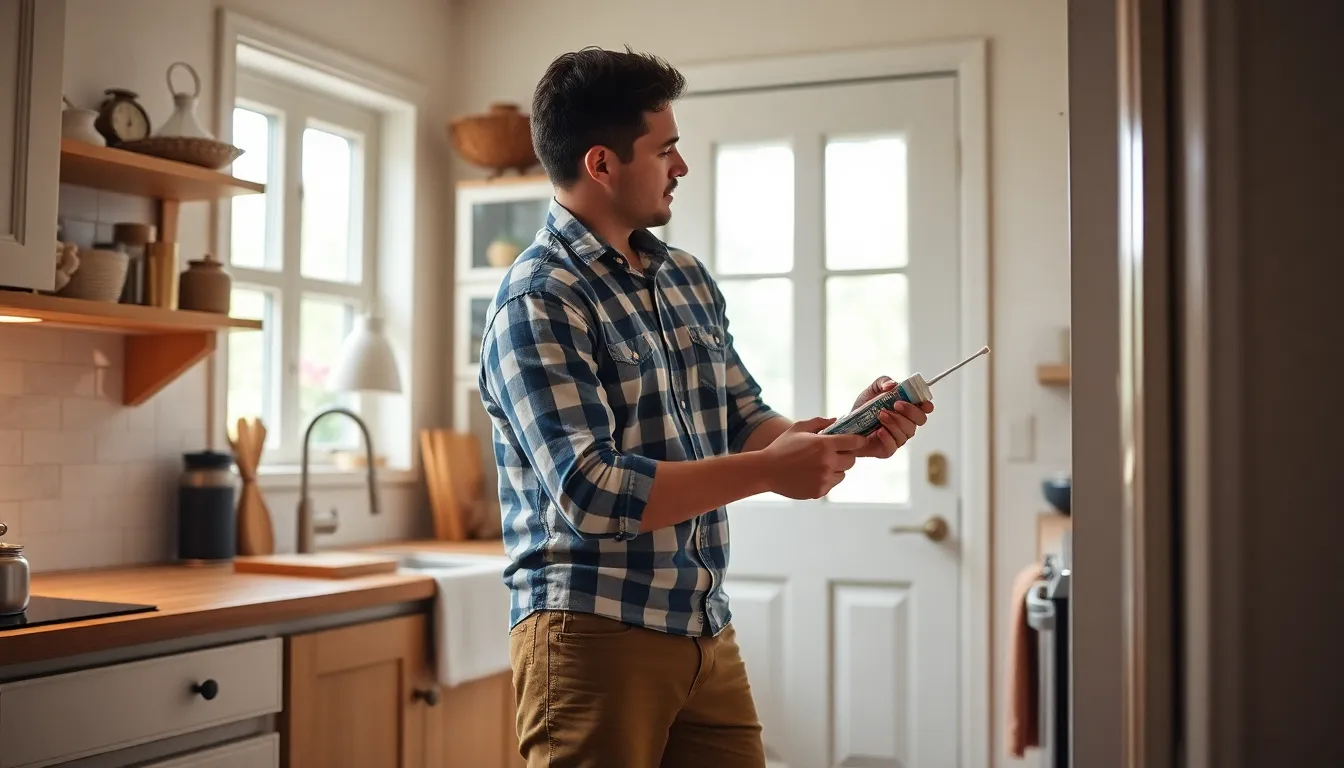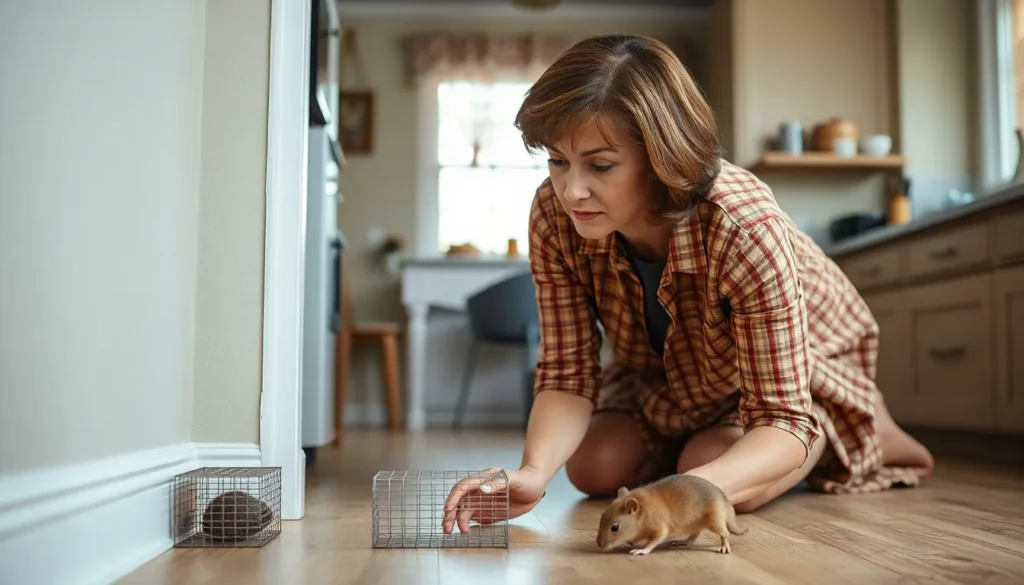Mice might be cute in cartoons, but in real life, they’re more of a nuisance than a cuddly friend. If those little critters have turned your cozy home into their personal playground, it’s time to take action. No one wants to share their snacks with tiny, whiskered intruders, right?
Table of Contents
ToggleUnderstanding the Mouse Problem
Mice in homes pose significant issues. While often viewed as harmless, they can lead to health risks and property damage.
Common Signs of a Mouse Infestation
Look for droppings, which appear as small, dark pellets found near food sources or nesting areas. Scratching noises, especially at night, indicate activity within walls or ceilings. Greasy marks along walls stem from mice rubbing against surfaces. Check for chewed wires or furniture, as these pests gnaw on various materials to maintain dental health. Nesting materials, including shredded paper and fabric, can be found in secluded areas, indicating a nearby nest.
Why Mice Invade Your Home
Mice search for warm, secure locations, particularly during colder months. Food availability attracts them, leading to kitchen raids. Poor sanitation practices, such as leaving food exposed, invite these pests inside. Overcrowded outdoor areas, such as piles of debris or dense vegetation, create an appealing habitat. Structural weaknesses in homes, like gaps around doors and windows, provide entry points. Understanding their motives can help in developing effective prevention strategies.
Prevention Measures

Taking proactive steps ensures a mouse-free home. Implementing effective prevention measures significantly reduces the likelihood of infestations.
Sealing Entry Points
Sealing entry points prevents mice from accessing the home. Inspect all windows and doors for gaps. Examine the foundation for cracks and seal them with appropriate materials. Cover vents and chimneys with screens that withstand rodent activity. Installing door sweeps on exterior doors blocks entry as well. Ensure the garage door fits snugly to prevent openings. Permanently close off any holes larger than a quarter of an inch. Mice can squeeze through tiny gaps, so thorough sealing is essential.
Maintaining Cleanliness and Hygiene
Maintaining cleanliness reduces the appeal of homes for mice. Regularly cleaning kitchens and dining areas removes crumbs and spills. Storing food in airtight containers prevents access to rodents. Disposing of garbage promptly and using bins with tight-fitting lids deters them as well. Vacuuming frequently eliminates nesting materials and other attractants. Keeping clutter to a minimum creates fewer hiding spots for mice. Regularly check behind appliances and furniture for food remnants. Proper hygiene practices significantly minimize the risk of an infestation.
Effective Trapping Techniques
Trapping is a practical method to eliminate mice. Selecting the right trap and placing it strategically increases success.
Types of Traps
Several types of traps aid in mouse control. Snap traps provide a quick kill using a spring-loaded mechanism, while glue traps immobilize mice when they walk across a sticky surface. Electronic traps deliver a lethal shock to mice in a contained environment. Live traps capture mice unharmed, allowing for release away from homes. Each type serves different preferences and circumstances, so consider the most suitable option based on the infestation severity and personal comfort level.
Setting Traps Strategically
Effective trap placement enhances results. Start by identifying high-traffic areas where signs of mice are evident, such as droppings and gnaw marks. Position traps along walls, as mice tend to travel close to surfaces. Use multiple traps in close proximity to increase capture rates, placing bait such as peanut butter or seeds to make traps more enticing. Regularly check and reset traps to prevent odors from deterring new mice. Monitoring traps consistently ensures a swift response to any new activity.
Natural Remedies
Natural remedies can help eliminate mice from homes without relying on harsh chemicals. Many homeowners prefer using these alternatives for effective pest control.
Essential Oils
Essential oils serve as a popular deterrent against mice. Peppermint oil stands out for its strong scent that mice find unpleasant. A combination of ten drops of peppermint oil mixed with water in a spray bottle can create an effective solution. Spraying this mixture around entry points and high-traffic areas discourages mice from entering. Lavender oil also acts as a natural repellent with its soothing aroma. Placing cotton balls soaked in these oils around the home enhances the effectiveness of this remedy.
Other Home Remedies
Other home remedies offer easy solutions as well. A mixture of water and vinegar repels mice due to its strong odor. Filling small bowls with this solution and placing them near potential entry points can deter unwanted visitors. Spice blends, particularly cayenne pepper and black pepper, create an unfavorable environment for mice. Sprinkling these spices near suspected nesting sites or entryways helps keep them at bay. Additionally, using baking soda mixed with sugar attracts mice, while the baking soda creates a harmful reaction in their digestive system. Implementing these remedies forms a comprehensive strategy for a mouse-free home.
Professional Extermination
Professional extermination offers a reliable solution for severe mouse infestations. Homeowners often face challenges when dealing with persistent mice, especially when initial prevention measures fail.
When to Call an Exterminator
Recognizing the right moment to contact an exterminator is crucial. Signs of a significant mouse infestation, such as consistent droppings, frequent scratching noises, or visible damage, indicate a severe problem. If DIY methods don’t yield results after a reasonable period, hiring a professional becomes necessary. Furthermore, individuals with severe allergies or health concerns should consider immediate professional intervention. Trusting experienced exterminators helps ensure effective removal and peace of mind.
What to Expect From Professional Services
Expect comprehensive assessments when hiring professional services. Initially, exterminators inspect the property to identify entry points and nesting areas. They assess the severity of the infestation and tailor strategies accordingly. Technicians utilize a blend of traps and bait that specifically targets the infestation, minimizing risks to non-target animals and humans. Post-treatment inspections often occur to confirm effectiveness and provide recommendations for future prevention. Homeowners can anticipate a follow-up to ensure that the infestation is entirely under control.
Taking proactive steps to rid a home of mice is essential for maintaining a healthy and comfortable living environment. By sealing entry points and maintaining cleanliness homeowners can significantly reduce the risk of infestations. Implementing effective trapping techniques and exploring natural remedies provides additional layers of defense against these unwanted pests.
When DIY methods fall short seeking professional extermination ensures a thorough approach to eliminating mice. Recognizing the signs of an infestation and acting swiftly can prevent further damage and health risks. With the right strategies in place it’s possible to enjoy a mouse-free home, allowing for peace of mind and a more enjoyable living space.



